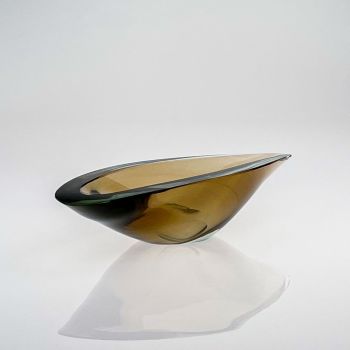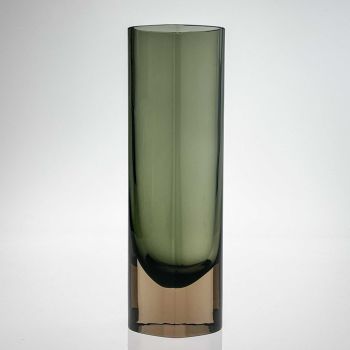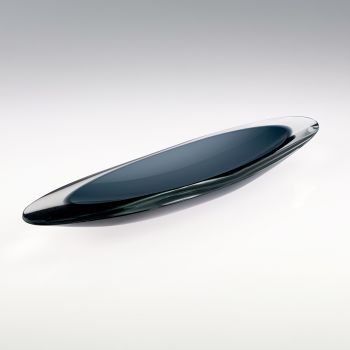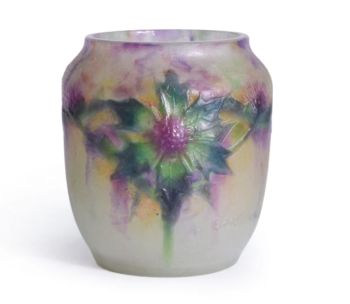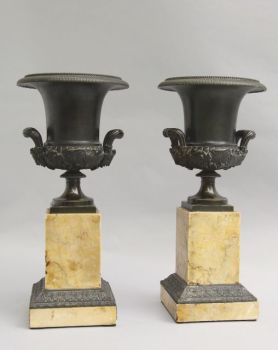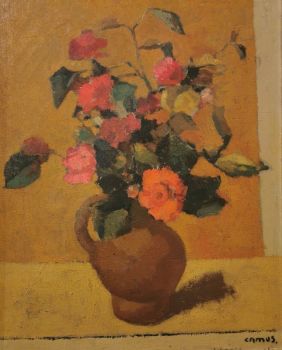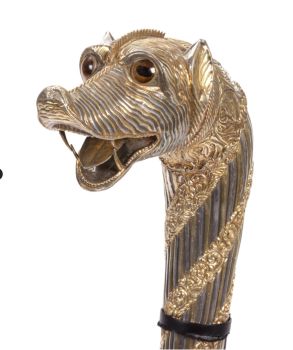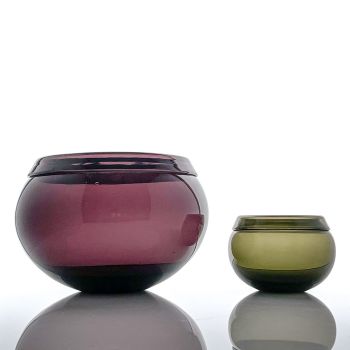Kaj Franck – A glass Art-object “Prisma”, model KF 215 in yellow and blue hues – Nuutajärvi-Notsjö, 1962
Kaj Franck
Vidrio
16 ⨯ 13 ⨯ 8 cm
ConditionGood
€ 1.350
Van Kerkhoff Art
- Sobre la obra de arteA free blown, cased glass, facet cut Art-object “Prisma”, model KF 215, in blue, yellow and green hues. Designed by Kaj Franck in 1953 and executed by the Nuutajärvi-Notsjö glassworks, Finland in 1962.
These rare vases were made between 1958 and 1968 in four different sizes ranges, this example falls within the medium-large (2nd largest size) range.
This “Prisma” is in good condition. No cracks or chips and only some light scratches. It is fully marked underneath the base in diamond-pen: K. Frank – Nuutajärvi-Notsjö – ’62 (1962).
About Kaj Franck
Kaj Franck (Vyborg, Finland 1911 – Santorini, Greece 1989), a pioneering Finnish designer and a prominent figure in the Finnish art world from 1940 to 1980, left an indelible mark on the design landscape. Today, his name is synonymous with excellence and innovation, as exemplified by the prestigious “The Kaj Franck Design Prize,” which is annually awarded by the esteemed Finnish Design Forum.
Born in 1911 on the Finnish-Russian border into a family with a rich architectural heritage, Franck had design in his blood. His grandfather held a prominent position as the director of the renowned Arabia Ceramics factory, underscoring the influence and inspiration that surrounded him from an early age.
Franck pursued his passion for design by studying at the furniture department of Taideteollinen korkeakoulu, known today as the Aalto University School of Arts, Design, and Architecture, in Helsinki. Equipped with a solid foundation in design principles, he embarked on a career as a freelance designer before joining Arabia in 1945. It was during his time at Arabia that Franck’s talent truly flourished, and in 1950, he assumed the role of the company’s Artistic Director.
While his contributions to Arabia were significant, Franck’s creative vision extended beyond ceramics. He also designed glass objects for Iittala between 1946 and 1950, and later for Nuutajärvi-Notsjö glassworks from 1950 to 1976. His designs, particularly in everyday tableware and glassware, propelled him to the forefront of the design world. Notably, his iconic Kilta tableware and Kartio glassware are celebrated as revolutionary and enduring symbols of classic Finnish design.
Franck’s design philosophy embodied a profound commitment to principles of moderation, ecology, and equality. Often referred to as “the conscience of Finnish design,” he advocated for minimalism and the conscious reduction of everyday objects, emphasizing the importance of sustainability and product life cycles. Franck’s designs were a testament to his belief that beauty and functionality could coexist harmoniously, enhancing the lives of individuals while respecting the environment.
Recognized for his exceptional contributions, Franck’s works grace the collections of esteemed museums worldwide. Noteworthy institutions such as the Design Museum Helsinki, the Museum of Modern Art in New York, the Stedelijk Museum Amsterdam, and The British Museum in London all proudly display his creations. Throughout his illustrious career, Franck received numerous accolades, including the prestigious Lunning Prize in 1955, as well as “Grand Prix” and multiple “Gold Medals” at the renowned Triennale di Milano.
Kaj Franck’s enduring legacy rests not only on his remarkable designs but also on his unwavering commitment to advancing the field of design. His vision, which emphasized sustainability, simplicity, and social consciousness, continues to inspire designers and enthusiasts alike, ensuring that his influence will be felt for generations to come.
Marked
Signed in diamondpen; K. Franck Nuutajärvi-Notsjö '62 (1962)
Execution
Nuutajärvi-Notsjö glassworks, Finland 1962
Condition
This Prisma is in very good condition, some light scratches and wear consistent with age and use. No chips or cracks.
Literature
Marianne Aav (ed.), Kaj Franck, Universal Forms, p.222, p.323
Dimensions
Height 16 cm
Width 13,5 cm
Depth 8,2 cm - Sobre el artista
El diseñador finlandés de cerámica y vidrio Kaj Franck (1911-1989) se dio cuenta de una poderosa verdad en su distinguida carrera: lo simple es hermoso. A pesar de que el mundo se mueve a un ritmo cada vez más acelerado, de una década a otra, esa simple verdad permanece. La inspiración y los principios de Franck iniciaron una tradición en el diseño finlandés, que aún hoy sigue viva y fuerte. Sus obras más conocidas son las series Iittala Teema y Kartio, y su herencia forma parte de todos los hogares finlandeses.
“Quiero hacer uso de objetos que son tan obvios que no se notan”, definió Kaj Franck su propio trabajo. Sus diseños atendían las necesidades humanas básicas mientras les servía herramientas con propiedades de objetos cotidianos. Franck también estaba interesado en objetos de bajo Costó la producción en masa y rehuyó el materialismo, la cultura del descarte y la ostentación El mundo de Franck consistía en formas matemáticas básicas y formas simples, decoradas solo con colores fuertes.
El punto de partida del trabajo de Franck fue la practicidad combinada con la belleza. Aunque hoy parece evidente, en su época su pensamiento era radical. Franck separó los estilos y las tendencias de la moda de la tradición y le dio un significado completamente nuevo. En el período de 1952 a 1953, Franck demostró que la vajilla no necesita ser demasiado compleja con el lanzamiento de la serie Kilta como una declaración fuerte: era una idea novedosa que todos podían configurar la mesa según sus propias necesidades.
Franck comenzó sus diseños centrándose en la idea o el concepto subyacente, no en la forma. Este énfasis en el aspecto de la idea del diseño también se trasladó a su trabajo como profesor y más tarde como director artístico en la Universidad de Arte y Diseño de Helsinki. Franck también fue uno de los primeros defensores del reciclaje, y a menudo se le ha llamado la "conciencia del diseño finlandés". Franck ganó muchos premios en su distinguida carrera y se hizo famoso internacionalmente. Hoy en día, el premio Kaj Franck es el reconocimiento de diseño más prestigioso de Finlandia. .
¿Está interesado en comprar esta obra de arte?
Artwork details
Related artworks
- 1 - 4 / 9
- 1 - 4 / 24
- 1 - 4 / 24
Johann Loetz (Lötz) Witwe Klostermühle
Johann Loetz Witwe – Jugendstil Cobalt Papillon vaas1900 - 1910
Prix sur demandeAntiques Emporium
1 - 4 / 24René Lalique
Un ancien vase 'Bluets' conçu par René Lalique (1860-1945)1910 - 1920
Prix sur demandeLennart Booij Fine Art and Rare Items
Artiste Inconnu
An Indian part-gilt silver-clad ceremonial sceptre or mace with a tiger’s head1850 - 1900
Prix sur demandeZebregs & Röell - Fine Art - Antiques
 Sélectionné par
Sélectionné parDanny Bree
René Lalique
Un très rare vase «Fougères» vert foncé conçu par R. Lalique1912
€ 8.950Lennart Booij Fine Art and Rare Items
 Sélectionné par
Sélectionné parSilla Scheepens
Johann Loetz (Lötz) Witwe Klostermühle
Johann Loetz Witwe - Phänomen Genre 7773 – Orange1900 - 1910
Prix sur demandeAntiques Emporium
Artiste Inconnu
Un rare filigrane un gobelet retortoli1550 - 1600
Prix sur demandePeter Korf de Gidts - Antiquairs
1 - 4 / 24Børge Mogensen
Teak wood “dropleaf” desk – Søborg Møbler, Denmark circa 19551950 - 1960
Prix sur demandeVan Kerkhoff Art
1 - 4 / 12










